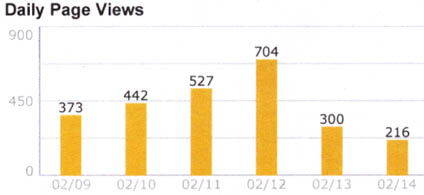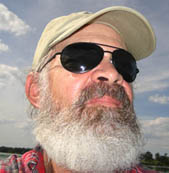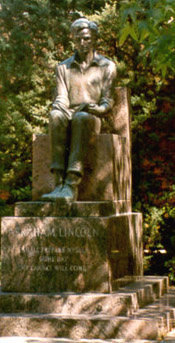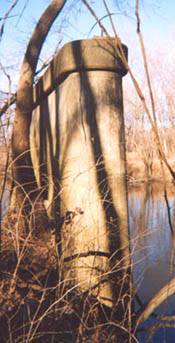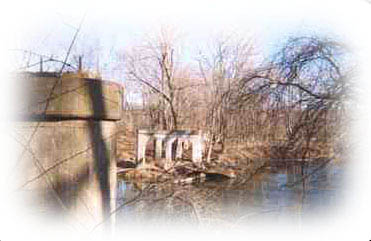Introduction: The Site's Purposes
"The
past is forever being swept away in the interest of neatness and order. It is unforgivable, or at least I don't intend to forgive it."
Lincolnite award-winning Author William
Maxwell, Ancestors (1971), p. 244.
William Maxwell
(1908-2000), a native of Lincoln, Illinois, wrote 11 short stories, 4
novels, and a nonfiction book of family history (Ancestors ) based on
his hometown (the first namesake city of Abraham Lincoln). Maxwell was also
a fiction editor ofThe New Yorker magazine for forty years
(1936-1976), working with such luminaries as Harold Brodkey, John Cheever,
Frank O'Connor, John O'Hara, Mavis Gallant, John Updike, and Eudora Welty.
Maxwell's 1980 novel, So Long, See You Tomorrow , won the American
Book Award and the Howells Medal of the American Academy of Arts and
Letters.
"The creation of a culture at any time and for any society requires its
re-creation from the materials of the past. And that act of re-creation, the
search for a 'usable past,' as Van Wyck Brooks termed it, ought to be as
ongoing and as serious as anything we do." Professor Robert C.
Bray, Rediscoveries: Literature and Place in Illinois, p. 11.
Mr. Lincoln, Route 66, and Other Highlights of Lincoln, Illinois
protests the arbitrary "sweeping away" of history and seeks to advance the
noble quest for a "usable past." This Web site is the result of a journey to
discover a truly "usable past" for me personally and for others associated
with my hometown. Many people have a natural curiosity about the
social factors that have shaped their lives, especially their families and
their hometowns. My hometown is Lincoln, Illinois; and I have studied its
history for insight into how this community influenced my parents'
generation, my generation, and me. The last few years have afforded me the
opportunity to investigate Lincoln's history more thoroughly than in my
younger years.
I have
learned a great deal, exploring how this community is unique and how it is
typical of small Midwestern towns. This information has helped me to probe
the "mixed feelings" about Lincoln that I have experienced since adolescence
(of course, many others have similar views of their hometowns, large or
small). This project has strengthened my view that overall the experience of
my formative years in Lincoln (1942-1961) was positive. My family life was
good, and at Lincoln Community High School and Lincoln College, I discovered
the subjects I have always enjoyed studying and teaching--literature and
writing. I remain a "Lincolnite at heart." Thus, I
have created this book-length community history Web site as a "distance"
public service to inform viewers about
the rich heritage and promising future of Lincoln, Illinois.
This site
aims to strengthen the civic pride of former and current (and future) Lincolnites,
to inform all viewers about the first Lincoln namesake town--its past, its
present, and its future prospects--, to inspire viewers to become more
interested in the cultural history of the Land of Lincoln,
and to encourage people to visit this historic central Illinois city
(population about 16,000) (heritage tourism).
Next, I summarize
the historical and cultural distinctions of Lincoln, Illinois--the subject
matter of Mr. Lincoln, Route 66, and Other
Highlights of Lincoln, Illinois. This Web site typically devotes one or more
chapter-length "Web pages" to various topics in an attempt to
offer a comprehensive, interesting history. The Introduction (link below) provides a more
detailed explanation of the site's content, contributors, intended
audiences, organization, and writing style.
The most celebrated historical distinction of Lincoln, Illinois, is its association with
Abraham Lincoln. In 1853, Abraham Lincoln was the attorney for the railroad whose
construction led to the establishment of the town. Abraham Lincoln was also
the attorney for the three men who founded Lincoln, Illinois, the seat of
Logan County. The attorneys asked Mr. Lincoln for permission to name the new
town after him. Legend has it he noted that nothing named Lincoln ever
amounted to much, but he agreed to give the town his name. Near the train depot on August 27, 1853, Mr. Lincoln
christened this first namesake town with watermelon juice in a public
ceremony. Lincoln, Illinois, is thus the first town named after Abraham
Lincoln before he became famous.
In Lincoln, Illinois, Mr. Lincoln frequently practiced law, occasionally substituted
as a judge, owned property, and engaged in politics until his election as
the 16th President in 1860. Today Lincoln, Illinois, is home to many
historic sites associated with Mr. Lincoln (he disliked the nickname "Abe").
A second major "claim to fame" of Lincoln, Illinois, is its close connection
to Route 66, arguably the world's most famous highway. Throughout much of
Illinois, Route 66 paralleled the alignment of the railroad whose
construction led to Lincoln's founding, and many miles of Route 66 pavement
and bridge remnants remain in Lincoln and Logan County. This Web site
presents much information, including maps and color photos, about Route 66
in this area.
Another distinction of Lincoln, Illinois, is that many successful writers
lived there, including
Langston Hughes, William Maxwell, Theologian Reinhold Niebuhr, and Robert
Wilson. Maxwell and Wilson based many of their stories on Lincoln, Illinois;
and I devote a separate chapter/page to Wilson. The site contains quotations
from many of Maxwell's Lincoln-based works, and presently I am developing a
chapter/page on Maxwell's portrayal of Lincoln's social classes (to be
published late in the spring of 2005).
This Web site attempts to interest and inform a wide audience--ranging from
students and teachers at all levels to casual viewers. To do so, I develop various topics of historical
and cultural significance, supplementing them with rich visual material: published
and original photos, maps, and vintage picture postcards. Information in
this site derives from more than 100 published sources, including county and
city histories, the novels and short stories of award-winning Author
William Maxwell, and the work of Illinois Appellate Court Justice James A. Knecht. Also, this Web site includes the recollections of Lincolnites from
three generations: family history written by my grandmothers and Uncle
Gilbert "Gib" Wilson (1928--2005), oral history from my father, and memoir I
have written about growing up in Lincoln.
Additionally,
more than two dozen alums of Lincoln Community High School
(LCHS) have contributed memoir to this project. Most of them graduated from
LCHS in the 1950s and 1960s. A few of these alums still live in Lincoln, but
many are scattered throughout the US. In 2001, I began to identify LCHS
alums from mid-20th century who had email addresses. I wrote them to ask if
they would like to reminisce online. Since then, many of these "Lincolnites
at heart" have emailed one another
stories, comments, and photos relating to their formative years in Lincoln,
and they have generously agreed to share that
material here. I list these contributors on the Introduction page, and I
provide email links for the contributors throughout the site wherever I use
their material. You are encouraged to respond to these folks with
comments and questions.
I am confident that you will find this Web site engaging, and here you will
find plenty of useful information to help guide your visit to the namesake town.
This information will better enable you to understand and enjoy Lincoln's sites on the National Register of Historic Places
and Lincoln's
museums, parks, festivals, fairs, and races at the new Lincoln Speedway.
A good place to enter this Web site is the Introduction (link below). The
Introduction and the navigation panel at the left of all interior pages
provide links to online reviews of this Web site in the Lincoln Courier and Lincoln
Daily News.com,. The site map page also presents "Lincoln online," a
feature article in the Peoria Journal Star (7-5-04).
Note:
If you printed this entire Web site as of 10-2006, you would need 2,500+
sheets of paper (more than five reams). My plan is to complete this project
in 2008, burn copies of this site on CDs, and offer them to libraries,
including the libraries of various colleges and universities in Illinois,
the Public Library of Lincoln, Illinois, the Abraham Lincoln Presidential
Library, the Smithsonian, and the Library of Congress. Thanks to
contributors: they have helped to create a new kind of history--an
unprecedented blend of historical and literary material, collective memoir,
and visuals ranging from maps to picture postcards to published and original
photos.




